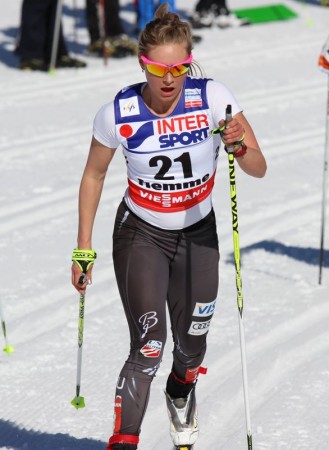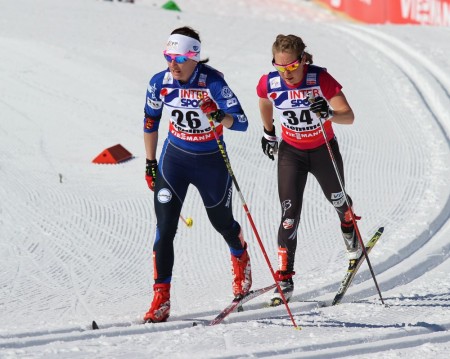
FasterSkier’s coverage of the 2013 FIS Nordic World Ski Championships in Val di Fiemme, Italy, is brought to you by the generous support of Fischer Sports.
VAL DI FIEMME, Italy — The World Championship 30 k wasn’t the perfect race for the American women, but all things considered Liz Stephen and Ida Sargent were satisfied with the effort it took to ski a challenging race that was dictated by slow, saturated snow, 50oF heat and tricky waxing conditions. Stephen was 16th, tying her performance in the 30 k two years ago in Oslo, and Sargent finished 25th in her debut in distance at a championship event.
Jessie Diggins, after crashing on the first lap, dropped out before the 10 k mark and did not finish.
“Solid,” was the word U.S. Ski Team women’s coach Matt Whitcomb used to describe the day for the team.
“Definitely neither felt like they had a stellar race, to say the least,” he said. “It’s a tricky day with the conditions and the ski changes, and I think we did OK. I didn’t look like anyone hit it out of the park there except maybe some of the top skiers, but they always look like they have good skis. So I think we were in there and it’s just a long, hard 30 k and slow, slow conditions. It’s probably the hardest 30 k course that we’ve seen.”
The crash that eventually made Diggins drop out was also where the race broke apart on the first lap outside the view of TV cameras, and athletes who were in it or behind it watched the leaders move away earlier than they would have liked, Stephen included.

“There was a really big crash on the elevator shaft the first lap; there were at least 15 people down,” Stephen said. “A lot of us lost the lead pack and it was hard to catch back up to them.”
Diggins continued for a few kilometers after her fall, but later pulled over when she decided the pain developing in her side might be cause for concern.
“I went down hard on my right side and then couldn’t stop sliding and slammed right into another girl, scraping my ribs over her skis,” Diggins said. “I got checked out by the team doctor afterwards and I’m injury-free, thank goodness, but during the race my ribs hurt a lot and I started to panic and worry about it, and since I was skiing by myself near the back already I decided dropping out would be smarter in the long run.”
Further ahead in the field, Stephen and Sargent began to ski alone. There were still other people around them towards the end of the first 5 k, but after the first ski change the top fifteen pulled away and the Americans were mostly by themselves for the middle section of the race. Mentally, the scenario presented both women with the challenge of staying in race mode despite the out-of-sight leaders and soft snow slowing them down.
“My brain kind of decided I wasn’t racing anymore for like 10 k,” Stephen said. She also had trouble taking feeds, and was only able to take in water throughout the race.
Sargent experienced problems with overheating in the hot, sunny conditions. The Americans raced in T-shirts, but as the race wore on under a hot sun Sargent developed a somewhat debilitating headache.

“It was kind of a suffer-fest to get to the finish; it felt a little bit like a death march out there,” Sargent said. “I kept getting these headaches because it was so hot, and then I’d dump water on my head and that would help for a little while and then it’d get really hot again.”
Though neither Sargent nor Stephen had ideal positioning in the first 15-20 k of the race, Whitcomb was impressed that both women skied well enough to bring themselves back a little by the end. On the last lap other skiers started coming back to the Americans, and they were able to compete with them and finish well.
“It looked like Ida and Liz could resurrect themselves a little bit at the end of the race and finish strong,” Whitcomb said. “It’s a battle of attrition out there, for sure, and you have to hang with it and people will start coming back to you if you keep the pedal down.”
Stephen caught Aino-Kaisa Saarinen (FIN) on her last lap, and at the finish came out 13 seconds ahead of her. He final time, 1:32:12.0, was 4:52.1 off Marit Bjørgen’s winning mark.
“There were a few people to ski with and that really helps change your outlook on things,” Stephen said. “I didn’t want to just hang out with people and ski with them, so I was trying to kind of make the group work and we finally caught [Saarinen] and that’s a major boost out there. Julia Ivanova and I were skiing together for most of the race and she was better on certain parts and I was better on certain parts, and it keeps your brain in it.”
Sargent came in 25th, five seconds behind Italy’s Debora Agreiter and nearly half a minute ahead of the next finisher, Eva Vrabcova-Nyvltova (CZE). She felt good about a top-30, though there were only 39 finishers, but wished her heat-induced headaches wouldn’t have prevented her from pushing her pace.
“It was good to be in the top-30, I guess, I don’t know,” Sargent said. “It would have been nice to ski with more people out there. I felt good the whole time, but with the heat I couldn’t push harder than a certain level, so I was kind of just going at one pace and suffering.
“I’m looking forward to shorter races the next few weeks,” she concluded with a relieved laugh. “You won’t see me in Holmenkollen.”
Stephen noted that the 30 k had the added challenge of being first marathon distance anyone on the World Cup does all season, and suggested that one practice race on the circuit before a championship would probably be helpful to athletes.
“The longest race we do until today is 15 k and this is literally double it,” she said. “I think we should have one more 30 k on the World Cup before Oslo and before championships like this, because it is a very different race and it would be good, I think, for us longer-distance skiers to have a practice round before world champs. But the TV seems to like the shorter ones, so I understand.”
The U.S. only started three women in the 30 k. Kikkan Randall came to Val di Fiemme planning to race the event, but after learning her distance form is currently not where she would like it to be she decided to give herself the day to rest and get ready for the end of the World Cup season, which begins again in Lahti, Finland, on March 9.
“I feel like racing today would have been a big battle, physically and probably mentally,” she said. “I basically now have two or three extra days to recover from the races I did, and hopefully…give my system a chance to rebuild for these last couple weeks of the season. It’s good, high-level, important racing… Especially with next weekend being important for the sprint cup and good distance racing to come around I felt like it was the better decision.”
The 30 k was the final event for the women at World Championships. Though the Americans didn’t end on the highest note they’ve hit all week, Stephen was upbeat after the finish.
“I’m happy with the race and really happy with the championships,” she said.
— Alex Matthews contributed reporting.
Audrey Mangan
Audrey Mangan (@audreymangan) is an Associate Editor at FasterSkier and lives in Colorado. She learned to love skiing at home in Western New York.



